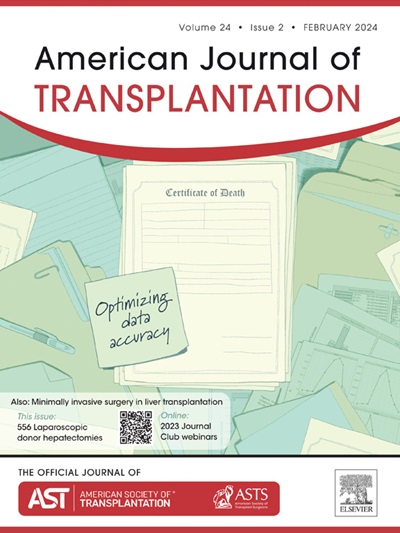肾移植中的同种异体反应性适应性自然杀伤细胞:对同种异体移植微血管炎症的潜在贡献。
IF 8.9
2区 医学
Q1 SURGERY
引用次数: 0
摘要
抑制性杀伤细胞免疫球蛋白样受体(ikiir)由自然杀伤细胞(NK)亚群随机表达,并识别HLA - i类同种异体共有的基序。这种相互作用阻止了NK细胞的自身反应性,同时增强了它们对缺乏这些hla - 1分子(缺失自我)的细胞的反应,这种情况在移植中被定义为ikr - hla - 1不匹配(ikr - mm),其基因型预测与微血管炎症(MVI)有关。本研究比较了MVI≥2的肾移植受者(KTR) (n=19)和MVI≤1的对照组(n=36)的iir - mm。iir - mm在MVI≥2患者中更为常见,与此同时,流式细胞术将推测的同种异体反应性iir - mm NK细胞定义为具有自身特异性但缺乏供体特异性iKIR的NKG2A(-)细胞。尽管两组患者均检测到iir - mm NK细胞,但MVI≥2的患者移植前NK细胞数量更高(中位数=11.02,IQR=0-58.31 vs中位数=0,IQR=0-9.46),尤其是存在DSA或C4d且与MVI分级相关的患者。MVI≥2的患者亚群显示移植前高比例和数量的寡克隆iir - mm NK细胞,显示与巨细胞病毒感染相关的NKG2C(+)适应性表型。这项初步研究为iir - mm NK细胞对MVI的贡献提供了一个新的视角,具有潜在的实际意义。本文章由计算机程序翻译,如有差异,请以英文原文为准。
Alloreactive adaptive Natural Killer cells in renal transplantation: potential contribution to allograft microvascular inflammation.
Inhibitory Killer-cell immunoglobulin-like receptors (iKIR) are randomly expressed by Natural Killer (NK) cell subsets and recognize motifs shared by HLA class-I allotypes. Such interactions prevent NK cell autoreactivity while enhancing their response against cells lacking those HLA-I molecules (missing self), a situation defined in transplantation as iKIR-HLA-I mismatch (iKIR-MM), whose genotypic prediction has been associated with microvascular inflammation (MVI). Herein we compared iKIR-MM in kidney transplant recipients (KTR) with MVI≥2 (n=19) and controls with MVI≤1 (n=36). In parallel to genetic analysis of iKIR-MM, which was more frequent in MVI≥2 patients, putative alloreactive iKIR-MM NK cells were defined by flow cytometry as NKG2A(-) cells bearing self-specific but lacking donor-specific iKIR. Although iKIR-MM NK cells were detected in both groups, their pretransplant numbers were higher in MVI≥2 patients (median=11.02, IQR=0-58.31 vs median=0, IQR=0-9.46), especially in the presence of DSA or C4d and correlated with MVI grade. A subset of MVI≥2 patients showed pretransplant high proportions and numbers of oligoclonal iKIR-MM NK cells, which displayed an NKG2C(+) adaptive phenotype associated with cytomegalovirus infection. This pilot study provides a novel perspective on the contribution of iKIR-MM NK cells to MVI, with potential practical implications.
求助全文
通过发布文献求助,成功后即可免费获取论文全文。
去求助
来源期刊
CiteScore
18.70
自引率
4.50%
发文量
346
审稿时长
26 days
期刊介绍:
The American Journal of Transplantation is a leading journal in the field of transplantation. It serves as a forum for debate and reassessment, an agent of change, and a major platform for promoting understanding, improving results, and advancing science. Published monthly, it provides an essential resource for researchers and clinicians worldwide.
The journal publishes original articles, case reports, invited reviews, letters to the editor, critical reviews, news features, consensus documents, and guidelines over 12 issues a year. It covers all major subject areas in transplantation, including thoracic (heart, lung), abdominal (kidney, liver, pancreas, islets), tissue and stem cell transplantation, organ and tissue donation and preservation, tissue injury, repair, inflammation, and aging, histocompatibility, drugs and pharmacology, graft survival, and prevention of graft dysfunction and failure. It also explores ethical and social issues in the field.

 求助内容:
求助内容: 应助结果提醒方式:
应助结果提醒方式:


